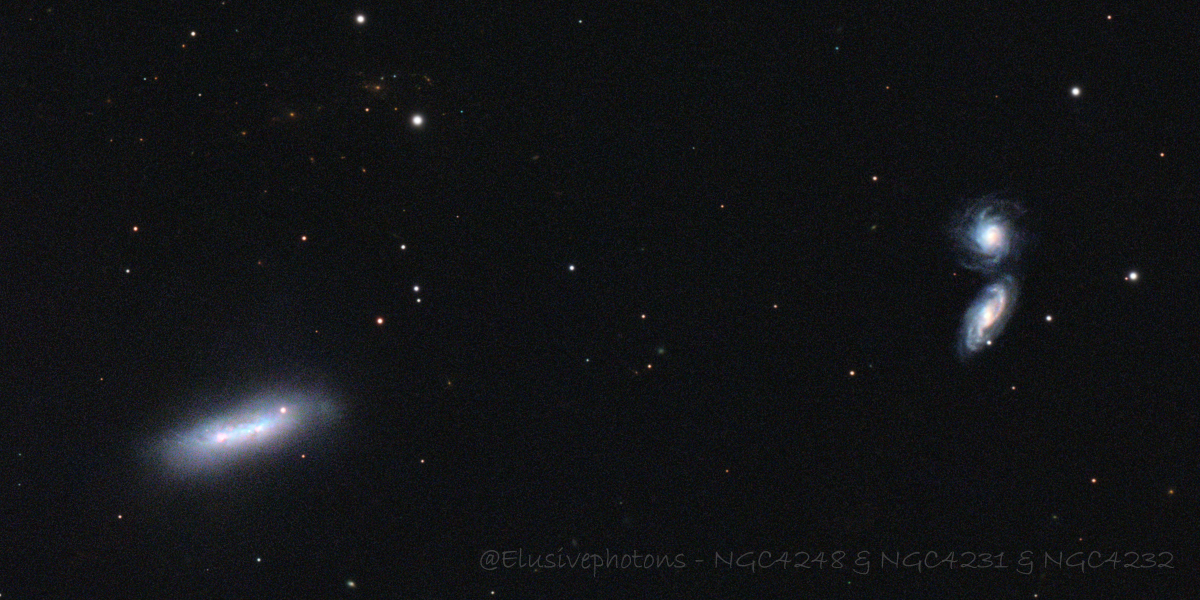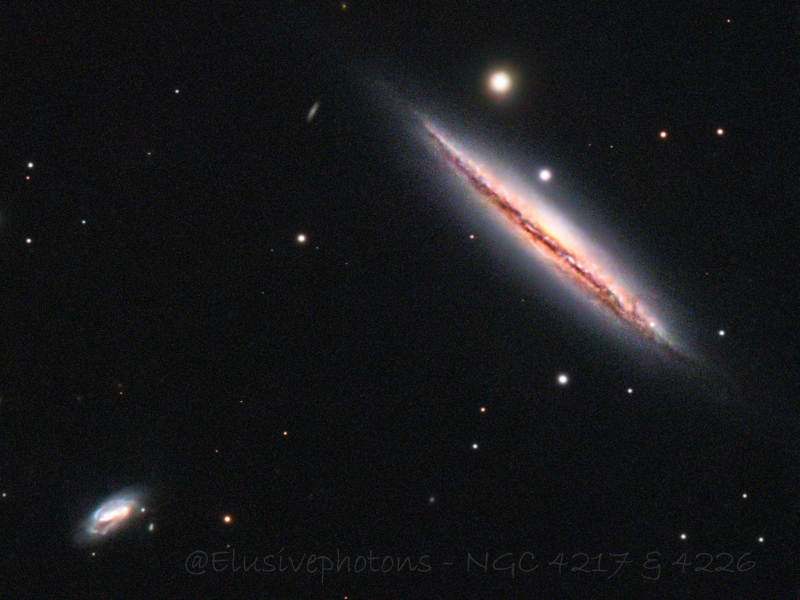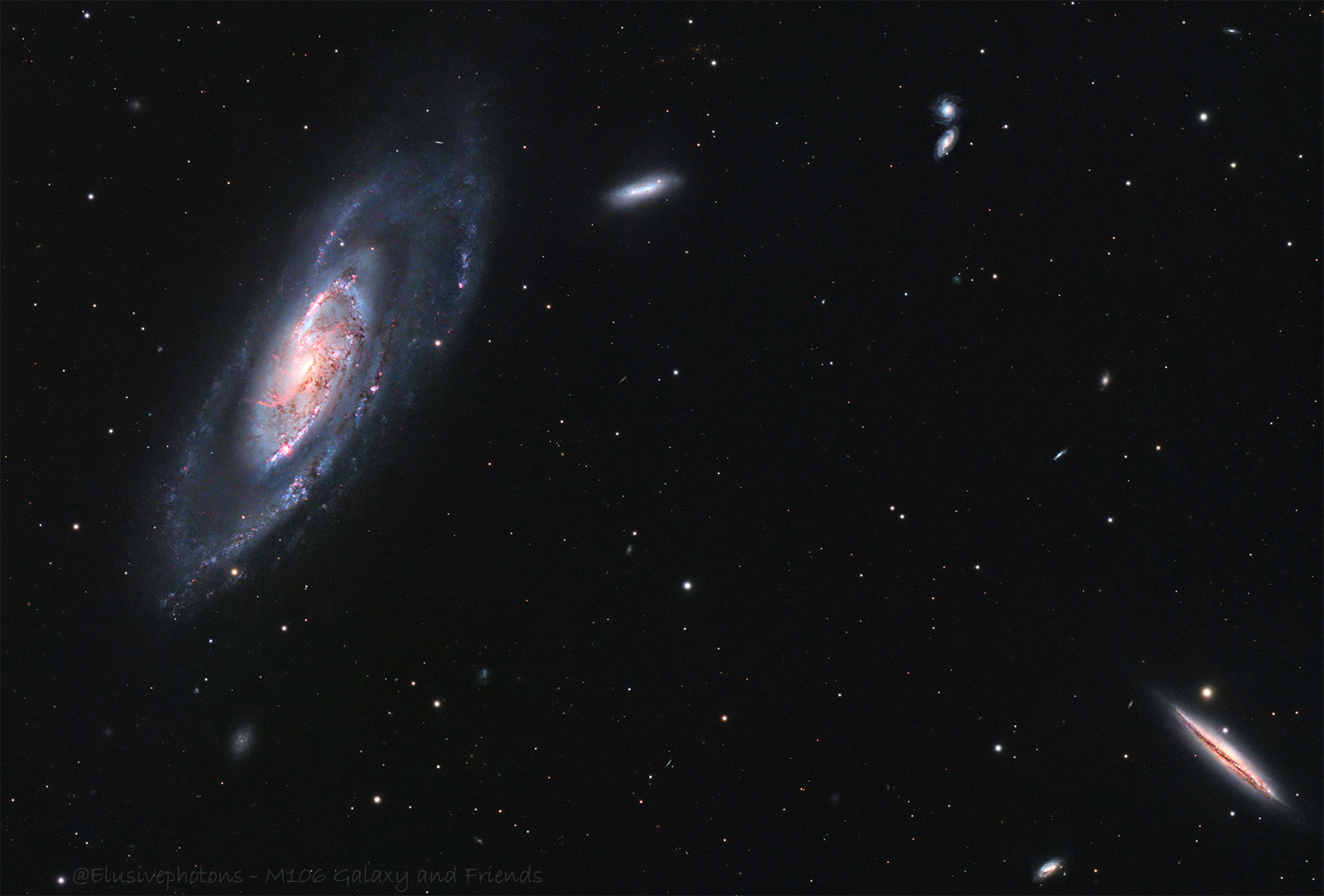Date:
March 30th - 2024
April 1,3,17,19,24,25,27,30 - 2024
May 1,2 - 2024
•
Exposure:
41 x 5 minutes Halpha (3hrs 25mins)
132 x 3 minutes Luminance(6hrs 36mins)
433 x 3 minutes (21hrs 39mins)
Total: 31hr 40min
About This Image
Gear:
Telescope: Stellarvue SVX130T-R
Mount: Software Bisque Paramount MYT
Camera: Player One Poseidon-C Pro • Player One Poseidon-M Pro
Filter: Player One IR/UV • Optolong L-Quad • Antlia Edge 5nm Ha
Accessories: 3.5" Feathertouch • Stellarvue SFFX3
Guiding: Player One FHD-OAG MAX • Player One Ceres-462M • PHD2
Software: Photoshop • PixInsight • TheSkyX • Starkeeper Voyager
Description:
M106, or Messier 106 (NGC 4258), is an intermediate spiral galaxy located in the constellation Canes Venatici, about 22 to 25 million light-years from Earth. With a diameter of roughly 135,000 light-years, it is one of the largest and nearest spiral galaxies visible to us and shines with an apparent magnitude around 8.4 to 9.1. M106 is known for its distinctive spiral arms and its very active galactic nucleus, which harbors a supermassive black hole actively accreting material and emitting strong radiation in the radio and X-ray bands.[1,2,3,4,5]
The area surrounding M106 in the sky is notably rich in other galaxies, making it a favorite among astrophotographers and observers. Close companions in the field include NGC 4217, an edge-on spiral galaxy with a prominent dust lane, which lies almost directly to the left of M106 and is approximately 60 million light-years away. Other notable galaxies in the vicinity include NGC 4220 (a lenticular galaxy), NGC 4226, NGC 4231, and NGC 4232 (a pair of close galaxies visible as faint patches), and NGC 4248, a small galaxy located near M106. These objects vary in type, distance, and brightness, adding to the complexity and interest of the M106 field.[6,3]
M106’s field is part of a region influenced by the outskirts of the Virgo Supercluster, which enhances the number of galaxies visible nearby. Deep imaging of this field can reveal even more background galaxies, with some amateur and professional surveys documenting dozens of faint PGC (Principal Galaxy Catalogue) galaxies down to magnitude 17 and fainter. The collective view offers a rare chance to compare diverse galactic morphologies and dynamics in a single area, such as the energetic core of M106, star-forming regions in its companions, and the quieter, dust-laden disks of edge-on neighbors like NGC 4217.[1,3,6]
Sources:
[1] en.wikipedia.org/wiki/Messier_106
[2] www.messier-objects.com/messier-106/
[3] www.bloomingstars.com/m106-friends/
[4] esawebb.org/images/potm2407b/
[5] esawebb.org/images/potm2407a/
[6] cosgrovescosmos.com/projects/m106-region
Distance: 22-25 Million light-years
Size: 135,000 light-years
|

The two galaxies NGC 4231 and NGC 4232 were discovered by William Herschel on 9 March 1788. With an angular extent of about 1.5 arc minutes, they are quite small and with a brightness of 15 magnitudes they are very faint. NGC 4231 is a spiral galaxy of the morphological type SA0, moving away at a speed of about 7400 km/s and lying at a distance of about 107 Mpc to 109 Mpc (349 to 355 million light years). NGC 4232 is a bar spiral of the morphological type SBb. It is somewhat closer to us at a distance of 104 Mpc to 107 Mpc (339 to 349 million light years) and is moving away at around 7200 km/s.
NGC 4248 was also discovered by William Herschel on the same day. It is an irregular galaxy that we see from the edge. Measured heliocentric speeds range from 445 km/s to 486 km/s and distances from 7.2 Mpc to 8.9 Mpc. It is therefore in the immediate vicinity of M 106, which is probably responsible for the appearance of NGC 4248 through gravitational interactions.

The galaxy NGC 4217 was discovered by William Herschel on 10 April 1788. It has an angular extent of about 5.2 x 1.5 arc minutes and an apparent magnitude of 12 magnitudes. We see it directly from the edge, which is why it is not entirely clear whether it is a classic spiral galaxy or a bar-shaped spiral galaxy. The heliocentric velocities measured in the last 20 years by means of spectral shifts range from 1000 km/s to 1031 km/s. Distances range from 17 Mpc to 20 Mpc (55 to 65 million light years).
NGC 4226 was discovered by John Herschel on 19 March 1828. With an angular extent of about 1.0 x 0.5 arc minutes, it is quite small and is only 14 magnitudes bright. The galaxy appears to have a bar-spiral structure. In the last 20 years, various measurements have been made, which showed heliocentric speeds of 7238 km/s to 7260 km/s. The resulting distances range from 104 Mpc to 121 Mpc (339 to 394 million light years).
Source: deepskycorner.ch/obj/m106.en.php
|



